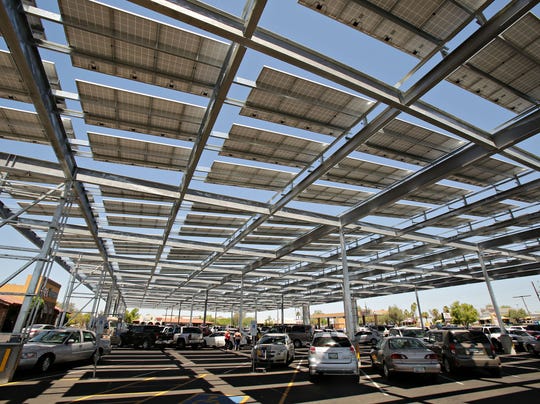 |
| The Fry’s Marketplace at 2727 W. Bell Road, Phoenix, has a solar array that covers most of the parking lot. (Photo: John Samora/The Republic) |
Fry's Food, for example, is piloting a solar program with a PowerParasol at its Phoenix store on Bell Road near Interstate 17. The solar shade structure covers 170 spaces of the grocery store's parking lot and is estimated to generate 80,000 kilowatt-hours a month.
"If we can be green, it's a plus for the environment and it keeps prices low," said JoEllen Lynn, a spokeswoman for Fry's Food Stores.
She said the company estimates it will save 20 percent of the store's energy costs.
Fry's is not the first retailer in the Phoenix area to dip its toe into solar usage. SanTan Village in Gilbert recently installed 2,877 solar panels. Desert Ridge Marketplace in Phoenix installed solar panels four years ago. And Glimcher Realty, the owner of Scottsdale Quarter, is considering incorporating solar energy as part of future expansions there.
Experts say that when businesses take notable steps to reduce carbon footprints in communities, they create value to customers.
"Overall, there's more acceptance from the public to be more sensitive to the needs of environment, and companies are trying to cater to that movement," said Rudolph E. Milian, senior vice president of best practices and publisher for the International Council of Shopping Centers in New York.
"If consumers know this particular shopping mall is doing things to be sustainable, they are more likely to approve it as a member of their community as being responsive to the environment. The important thing is how do we do our part to save energy."
Switching to solar energy isn't easy, and it's feasible for every business. The price of installing solar has come down in recent years, and the utility incentive programs that encouraged such installations have been scaled back as a result. Still, installing solar is an expensive proposition.
The average price to install solar panels on a business averages about $3.50 a watt nationally, according to the Solar Energy Industries Association. That means a 100-kilowatt system costs about $350,000. A 580-kilowatt system like the one at Fry's costs about $2 million, though Fry's would not confirm the price it paid.
Because of the costs, Milian said, malls usually aren't able to turn to solar unless incentives are available.
"It's going to take more incentives from the federal, utilities and state to make it feasible to the user," Milian said. "I think many consumers understand the need to have sustainable environment and that it's all going to help future generations."
Some of the states with the best incentives from government and utility companies include Hawaii, California, Arizona and New Jersey, Milian said. In Arizona, tax credits for businesses are 10 percent of the installation costs, up to $25,000 per facility in a tax year and up to $50,000 per taxpayer. If tax credits exceed the taxes due in a tax year, a taxpayer may carry the unused credits forward for up to the next five consecutive tax years.
The Fry's project was able to take advantage of the Arizona Public Service Co. incentive program before that program ended last year. Without the incentives from APS, the number of commercial solar projects has declined this year.
Other retailers and malls in Arizona making the switch to solar have yet to see a return on their investment, but they hope to reduce their utility bills.
The solar panels installed at SanTan Village have a capacity of 758 kilowatts. Macerich Co., which owns SanTan Village and other shopping malls across the country, is planning to install more than 10 solar projects at its other properties. So far, the mall developer has completed six projects in California, Colorado, New York and Arizona.
Desert Ridge Markeplace put in the first two of five solar installations four years ago. The solar system has a capacity of 550 kilowatts. The electricity is used for signage, accent lighting on building exteriors and parking-lot lights.
In May, Walmart announced it will double the number of on-site solar energy projects at its U.S. stores and distribution centers by 2020. The retailer's 36 solar-energy projects in Arizona produce 24,821,667 kilowatt-hours, which is enough to power 2,300 homes a year.
"Doing renewable power like this is the next step," said Jeff Bedell, vice president of sustainability for Macerich, the owner of SanTan Village. "It gives us a hedge on rising energy rates. When it's viable and where we can do it, we will look to do more solar."
Source: http://www.azcentral.com/story/money/business/2014/07/05/solar-energy-retailers-changing/12259327/
No comments:
Post a Comment